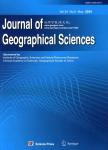Vegetation greenness modeling in response to climate change for Northeast Thailand
Vegetation greenness modeling in response to climate change for Northeast Thailand作者机构:Department of Environmental Engineering Khon Kaen University Khon Kaen 40002 Thailand Research Center for Environmental and Hazardous Substance Management Khon Kaen University KhonKaen 40002 Thailand
出 版 物:《Journal of Geographical Sciences》 (地理学报(英文版))
年 卷 期:2013年第23卷第6期
页 面:1052-1068页
核心收录:
学科分类:0709[理学-地质学] 07[理学] 08[工学] 081304[工学-建筑技术科学] 0706[理学-大气科学] 0813[工学-建筑学] 0704[理学-天文学]
基 金:supported by the Faculty of Engineering and the Higher Education Research Promotion and National Research University Project of Thailand Office of the Higher Education Commission and the Faculty of Engineering,Khon Kaen University,Thailand
主 题:Normalized Difference Vegetation Index (NDVI) vegetation greenness climate variability modeling
摘 要:In Northeast Thailand, the climate change has resulted in erratic rainfall and tem- perature patterns. The region has experienced both periods of drought and seasonal floods with the increasing severity. This study investigated the seasonal variation of vegetation greenness based on the Normalized Difference Vegetation Index (NDVI) in major land cover types in the region. An assessment of the relationship between climate patterns and vegeta- tion conditions observed from NDVI was made. NDVI data were collected from year 2001 to 2009 using multi-temporal Terra MODIS Vegetation Indices Product (MOD13Q1). NDVI pro- files were developed to measure vegetation dynamics and variation according to land cover types. Meteorological information, i.e. rainfall and temperature, for a 30 year time span from 1980 to 2009 was analyzed for their patterns. Furthermore, the data taken from the period of 2001-2009, were digitally encoded into GIS database and the spatial patterns of monthly rainfall and temperature maps were generated based on kriging technique. The results showed a decreasing trend in NDVI values for both deciduous and evergreen forests. The highest productivity and biomass were observed in dry evergreen forests and the lowest in paddy fields. Temperature was found to be increasing slightly from 1980 to 2009 while no significant trends in rainfall amounts were observed. In dry evergreen forest, NDVI was not correlated with rainfall but was significant negatively correlated with temperature. These re- sults indicated that the overall productivity in dry evergreen forest was affected by increasing temperatures. A vegetation greenness model was developed from correlations between NDVI and meteorological data using linear regression. The model could be used to observe the change in vegetation greenness and dynamics affected by temperature and rainfall.



